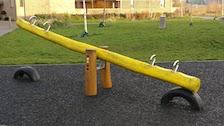
You can watch a recording of the webinar in which we discussed the mathematical thinking which can be prompted by these problems.
Getting the balance right
Seesaw shenanigans
A group of animals has made a seesaw in the woods. How can you make the seesaw balance?
Interactive balance
In this simulation of a balance, you can drag numbers and parts of number sentences on to the trays. Have a play!
Number balance
Can you hang weights in the right place to make the the number balance balanced?
Are you well balanced?
Can you work out how to make each side of this balance equally balanced? You can put more than one weight on a hook.
